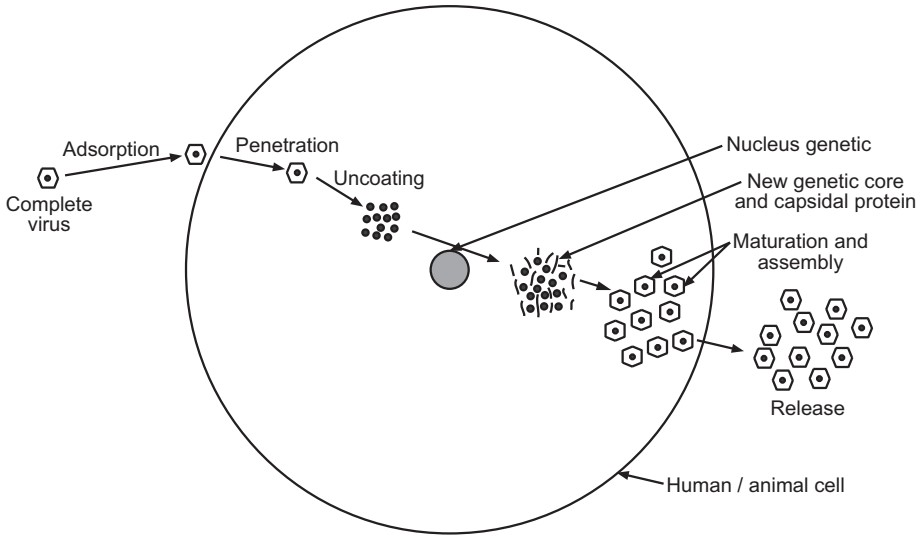Multiplication of Human Viruses: Virus depends on the synthetic machinery of a host cell for replication because it lacks biosynthetic enzymes. Early studies on viral replication employed the bacteriophage as a model. There are some similarities in the pattern of multiplication of bacterial and animal or human viruses. The steps of virus infection and replication can be divided into six sequential phases (Fig.1).

- Adsorption or attachment.
- Penetration.
- Uncoating.
- Biosynthesis of viral components.
- Maturation.
- Release.
1. Adsorption or attachment:
The virus is adsorbed at a particular site on the host cell which is called a ‘receptor’. Virions come in contact with cells by the random collision but adsorption or attachment is specific and is mediated by the binding of virion surface structures (ligands) to receptors on the cell surface. In the case of influenza viruses, the hemagglutinin on the virus surface gets attached to glycoprotein receptor sites on the surface of the respiratory epithelium. Destruction of the receptor sites by neuraminidase (RDE) prevents viral adsorption. In the case of the influenza virus, a surface glycoprotein binds specifically to the sialic acid residue of glycoprotein receptor sites on the surface of the respiratory epithelium. In the case of the human immunodeficiency virus surface glycoprotein-gp 120 acts as a
ligand. It binds to the CD4 60 KD glycoprotein on the surface of mature T lymphocytes. Similarly, the rabies virus binds to the acetylcholine receptor found on neural cells. Susceptibility to virus infection is based on the presence or absence of receptors on cells.
2. Penetration:
There are four possible mechanisms that the viruses use to enter a host cell. Non-enveloped viruses enter the cells by endocytosis or engulfment by the invagination of a section of the plasma membrane with the accumulation of virus particles in cytoplasmic vesicles (phagosomes). This is known as ‘viropexis’.
- Translocation is the process by which the whole non-enveloped virus enters the host cell by moving across the cell membrane.
- Fusion is the endocytosis of enveloped viruses in which the envelopes of the viruses fuse with the membrane of the endosome.
- The direct fusion of the virion envelope with the surface membrane of the cell also takes place in some of the families of viruses.
3. Uncoating:
This is a process by which the virus loses its outer layer and capsid. In some cases, uncoating is affected by the lysozomal enzyme of the host cell. In the poxvirus, uncoating is a two-step process. In the first step, the outer coating is removed by the lysozyme present in the phagocytic vacuole of the host cell. In the second step, the internal core of the virus (nucleic acid and internal protein) is released into the cytoplasm and is affected by the viral uncoating enzyme. Thus, DNA is released.
4. Biosynthesis of viral components:
There is a synthesis of viral nucleic acid, capsid protein, a regular protein that shut down normal cellular metabolism, and enzymes necessary in the various stages of viral synthesis, assembly, and release. The site of viral synthesis depends on the type of virus. DNA viruses synthesize their components in the host cell nucleus except for pox viruses which synthesize their components in the cytoplasm. Likewise, RNA viruses synthesize their components in the cytoplasm of the host cell except for orthomyxoviruses, paramyxoviruses, and leukoviruses.
Biosynthesis consists essentially of the following steps:
- Transcription of messenger RNA from the viral nucleic acid.
- Translation of messenger RNA (mRNA) into early protein. They initiate and maintain the synthesis of virus components and shut down the host protein and nucleic acid synthesis.
- Replication of viral nucleic acid.
- Synthesis of late proteins, which are the components of daughter virion capsids.
The critical step in viral biosynthesis is the transcription of mRNA from the viral nucleic acid. Once this is achieved, the host cell resources can be utilized for translating mRNA into viral components. Depending on the structure of their genome, viruses use different strategies for the transcription of mRNA.
In the case of DNA viruses, the DNA enters the host cell nucleus and uses the host cell enzymes for transcription (e.g. adenoviruses, papovaviruses). In hepadnaviruses which have partially double-stranded DNA, the duplex is completed by a viral DNA polymerase, inside the host cytoplasm. The mature DNA then moves into the nucleus, to be transcribed by host transcriptases.
In reoviruses, the double-stranded RNA is transcribed to mRNA by viral polymerases. Depending on the method of mRNA transcription, single-stranded RNA viruses are classified into two categories. In positive-strand RNA viruses, the viral RNA itself acts as the mRNA. Viral RNA is infectious by itself and is translated directly into viral proteins in the host cell cytoplasm (e.g. togaviruses). The negative-strand RNA viruses (e.g. paramyxoviridae) possess their RNA polymerases for mRNA transcription.
5. Maturation:
Assembly of daughter virion follows synthesis of viral nucleic acid and protein. It may take place in the nucleus (herpes, adeno) or the cytoplasm (picorna, pox). The enveloped virus gets an envelope from the cell membrane of the host during the process of budding. Non-enveloped viruses are present intracellularly as a fully-developed virions.
6. Release:
In bacterial viruses, the release takes place by lysis of the infected bacterium. In animals, virus release occurs without cell lysis (myxoviruses). Some viruses like polio may cause cell lysis during their release. The time taken for a single cycle of replication is about 15-30 hours for animal viruses. A single infected cell may release a large number of progeny virions.
Make sure you also check our other amazing Article on : Life Cycle of Bacteriophages
